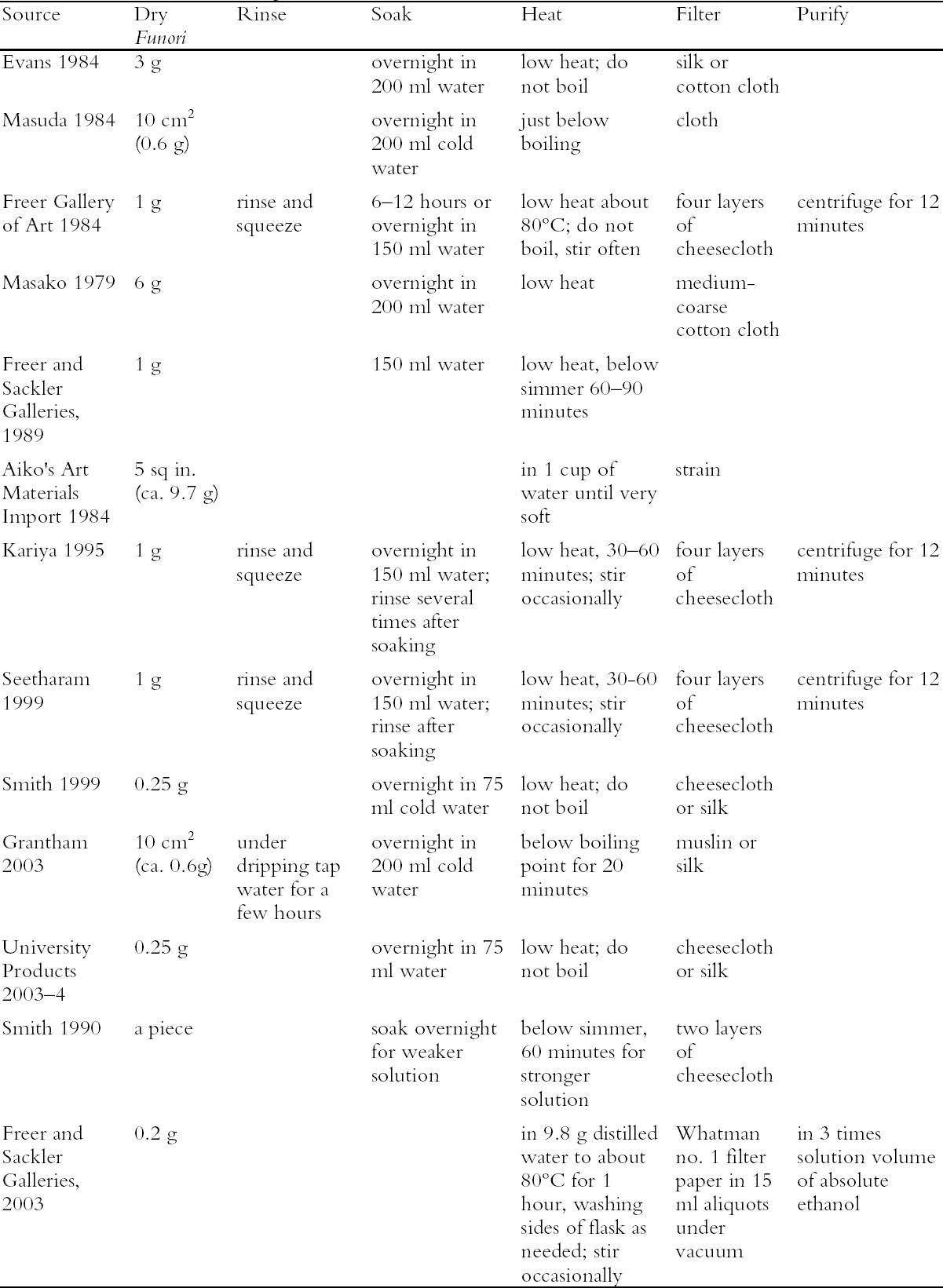FUNORI: OVERVIEW OF A 300-YEAR-OLD CONSOLIDANT
JOSEPH R. SWIDER, & MARTHA SMITH
3 LABORATORY STUDIES ON FUNORI PREPARATION
A survey of the conservation literature reveals a number of funori preparations, which are compiled in table 1 together with preparations used at the Freer and Sackler Galleries. In the scientific studies previously mentioned, raw funori is usually washed and given no further alkali treatment, as is typically done with carrageenans. Some methods only add funorans to boiling water (Takano et al. 1999); others soak and macerate it in a blender before adding it to boiling water (Takano et al. 1995; Takano et al. 1998). Many references in the conservation literature fail to give specific methods of preparation (Higuchi 1979; Oka 1988). Some references indicate a solution between 1% and 5% (Masuda 1984; Keyes 1986; Horie 1990; Kariya 1995) but do not provide dilution factors or a purchase origin.
The fact that funori is seldom treated before being sold to conservation studios casts doubts on its purity for use on cultural artifacts. Agar has been purified and separated for decades by a simple freeze-thaw method (Grabar 1959; Sewer 1983). As it thaws, agar remains a gel at room temperature while the water in it melts and is removed, presumably containing excess salts. Our freeze-thaw tests on funori showed that like most carrageenans, it cannot be purified by this method. We attempted to purify funori to produce a solution that was free of pulp and obvious extraneous material. A stock solution of 2% dry funori in distilled water (weight per weight) was heated at about 90�C for one hour and stirred occasionally. We used vacuum filtration with Whatman no. 1 filter paper, adding approximately 15 ml at a time because the filter quickly became clogged. The filtered product was clear of most fibrous pulp and other debris, and tinted slightly amber. It was almost clear when painted out on glass. It is a common practice in seaweed studies to precipitate a seaweed solution with ethanol, and we tested this practice as a final step. When approximately three times the filtrate volume
Table .
Funori Preparation Methods from Conservation and Commercial Sources
 |
of absolute ethanol was added to the filtered funori and stirred, a white, stringy precipitate immediately formed. The precipitate was dried on glass and dissolved easily in room temperature distilled water much like the funori prepared without ethanol precipitation. There was no clear advantage to using the ethanol precipitation step, except that the funori seemed to dry slightly faster.
Our laboratory purchased commercial funori and prepared it in a variety of ways to see if there was one standard “best” method. We divided the process into six stages: rinse, soak, heat, extract, dry, and reconstitute.
- Rinse: Although there is no evidence that salts and minerals are a problem, rinsing dry funori under dripping water (tap, deionized, or distilled) for 15 to 30 minutes is a reasonable precaution even though some of the soluble matter is lost in the process. This precaution has been confirmed in other studies (Michel et al. 2002).
- Soak: A solution forms faster during heating if the funori is soaked at room temperature or in a refrigerator for eight or more hours or overnight.
- Heat: Funori soaked in cold (not heated) water makes a dilute solution with weak strength. Heating it at or just below a simmer (about 60–90�C) for 60 to 90 minutes produces a more concentrated solution. Heating it longer than 90 minutes does not appear to extract additional material. Boiling does not weaken the tack of the funori, but a lower temperature lessens the danger of fast evaporation and burning. Water can be added during heating to prevent burning or to thin the solution.
- Extract: Clean, undyed fabric or a fine mesh plastic strainer can be used as a filter. Two to four layers of clean cheesecloth will filter out many fibers. Further filtering through silk or other fabrics with finer weaves will remove more fibers. Centrifuging or filtering with an aspirator vacuum through Whatman no. 1 filter paper removes even more fibers and leaves a pale, slightly cloudy solution that is aesthetically pleasing but not necessarily more useful. Vacuum filtration produces almost the same results as filtering through both cheesecloth and silk. As is done with many seaweeds, funori can be precipitated in absolute ethanol to produce a white, stringy precipitate. Salt is not needed to facilitate precipitation, though it is commonly used with agar precipitation. A solution of prepared funori can be kept under refrigeration for a short while until it begins losing its stickiness or grows mold.
- Dry: After heating, the solution can be poured onto clean glass, silicon-coated Mylar or Formica (Coombs 2003), where it forms a thin layer that can be scraped or peeled off when dry. Ethanol-precipitated funori can also be peeled off Formica or scraped off glass. Dry funori is difficult to remove from Mylar and saturates silicone-release paper. In our laboratories the dry, prepared funori has a shelf life of up to four years.
- Reconstitute: Dried prepared funori is easy to cut up and reconstitute to a desired concentration. It will dissolve in room temperature water in about 10 minutes (faster in hot water) and overnight in a refrigerator.
Preparing funori is a flexible procedure, and overall our attempts successfully produced a material that was free of debris and suitable for treating artifacts.
|
